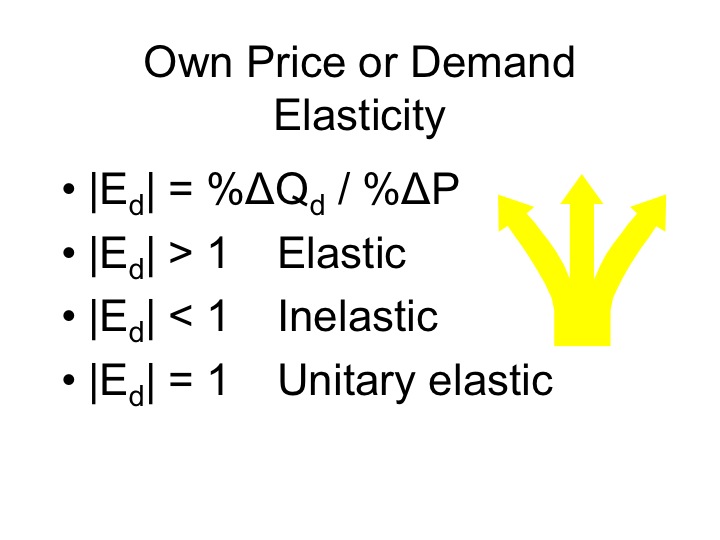The concept of price elasticity of demand is crucial in economics, as it helps businesses and policymakers understand how consumers respond to changes in price. When we say that the price elasticity of demand is greater than 1, we are referring to a situation where a percentage change in price leads to a larger percentage change in the quantity demanded. This indicates that consumers are highly responsive to price changes, making it important for businesses to strategize their pricing policies effectively. In the context of market dynamics, this high elasticity can significantly influence revenue and profit margins. For example, if a company's product has a price elasticity of demand greater than 1, a reduction in price could potentially lead to an increase in total revenue. Conversely, an increase in price could result in a substantial drop in sales, which businesses must carefully consider.
Understanding when the price elasticity of demand is greater than 1 is essential for identifying the types of products that consumers may view as luxuries or non-essentials. This knowledge can help companies tailor their marketing strategies and pricing approaches. Additionally, policymakers can leverage this information when considering taxation or subsidy scenarios. Ultimately, grasping the implications of price elasticity can lead to more informed decision-making in both business and public policy arenas.
In this article, we will explore various aspects of price elasticity of demand, particularly when it exceeds 1. We will answer questions related to its significance, provide examples, and discuss how businesses can utilize this information to their advantage.
What is Price Elasticity of Demand?
Price elasticity of demand (PED) measures how the quantity demanded of a good or service changes in response to a change in its price. It is calculated using the formula:
Price Elasticity of Demand (PED) = % Change in Quantity Demanded / % Change in Price
When the result is greater than 1, it signifies that demand is elastic. This means that consumers will significantly alter their buying habits in response to price fluctuations.
Why is Price Elasticity of Demand Greater Than 1 Important?
Understanding when the price elasticity of demand is greater than 1 is crucial for various reasons:
- Revenue Management: Businesses can adjust prices to optimize revenue.
- Market Strategy: Companies can identify which products are more sensitive to price changes.
- Consumer Behavior: Insights into consumer purchasing habits can inform marketing strategies.
- Policy Formulation: Governments can make informed decisions regarding taxes and subsidies.
How Do Businesses Use Price Elasticity of Demand?
Businesses use price elasticity of demand to strategize pricing models and sales tactics. For instance, if a business knows that its product has a price elasticity of demand greater than 1, it might consider the following strategies:
- Implementing promotional discounts to increase volume sales.
- Conducting market research to understand consumer preferences.
- Monitoring competitor pricing to maintain a competitive edge.
- Adjusting inventory levels based on anticipated demand changes.
What Factors Influence Price Elasticity of Demand?
Several factors can affect the price elasticity of demand:
- Availability of Substitutes: The more substitutes available, the more elastic the demand.
- Necessity vs. Luxury: Necessities tend to have inelastic demand, while luxuries are more elastic.
- Proportion of Income: Goods that take up a larger portion of income are usually more elastic.
- Time Horizon: Demand elasticity can change over time as consumers adjust to price changes.
Can Price Elasticity of Demand Change Over Time?
Yes, the price elasticity of demand can change over time due to various factors. For example, if a product initially has a price elasticity of demand greater than 1, changes in consumer preferences or the introduction of better substitutes can lead to fluctuations in demand elasticity. Businesses must constantly evaluate market conditions and adapt their strategies accordingly.
Real-World Examples of Price Elasticity of Demand Greater Than 1
Several types of products exhibit a price elasticity of demand greater than 1:
- Luxury Goods: Items such as designer clothing and high-end electronics often see a significant drop in demand when prices rise.
- Non-Essential Services: Services such as spa treatments or vacations can be highly elastic, as consumers can choose alternatives.
- Seasonal Products: Holiday-themed items may experience elastic demand as consumers are sensitive to price changes during specific seasons.
How Can Policymakers Utilize Price Elasticity of Demand?
Policymakers can leverage insights from price elasticity of demand to design effective economic policies. For example:
- Taxation: Understanding which goods have elastic demand can help in deciding which products to tax without causing significant consumer backlash.
- Subsidies: Providing subsidies for products with elastic demand can stimulate consumption and support specific industries.
- Regulation: Policymakers can regulate prices in markets where demand is highly elastic to protect consumers from excessive price increases.
Conclusion: The Impact of Price Elasticity of Demand Greater Than 1
In conclusion, understanding that the price elasticity of demand is greater than 1 is vital for businesses and policymakers alike. It provides insights into consumer behavior, helping to inform pricing strategies, revenue management, and economic policies. By recognizing the factors that influence price elasticity and monitoring market conditions, businesses can effectively navigate the complexities of consumer demand and optimize their operations. Whether you are a business leader, a marketer, or a policymaker, grasping the implications of price elasticity will undoubtedly enhance your decision-making processes in today’s dynamic economic landscape.
Understanding Sentencing For ABH: A Comprehensive Guide
Exploring The Dark Side: What Is A Disadvantage Of The McDonaldization Of Society?
Unveiling The Controversy: The Bad Word Starting With A


